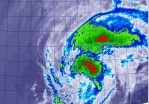Healthy fats help diseased heart muscle process and use fuel
2014-09-29
(Press-News.org) Oleate, a common dietary fat found in olive oil, restored proper metabolism of fuel in an animal model of heart failure.
The findings are reported in the journal Circulation by researchers at University of Illinois at Chicago College of Medicine.
Heart failure affects nearly 5 million Americans, and more than half a million new cases are diagnosed each year. Heart failure is not the same as having a heart attack -- it is a chronic disease state where the heart becomes enlarged, or hypertrophic, in response to chronic high blood pressure which requires it to work harder to pump blood. As the heart walls grow thick, the volume of blood pumped out diminishes and can no longer supply the body with enough nutrients.
Failing hearts are also unable to properly process or store the fats they use for fuel, which are contained within tiny droplets called lipid bodies in heart muscle cells. The inability to use fats, the heart's primary fuel source, causes the muscle to become starved for energy. Fats failing hearts manage to metabolize break down into toxic intermediary by-products that further contribute to heart disease.
Lewandowski and his colleagues looked at how healthy and failing intact, beating rat hearts reacted to being supplied with either oleate or palmitate, a fat associated with the Western diet and found in dairy products, animal fats and palm oil.
When the researchers perfused failing rat hearts with oleate, "we saw an immediate improvement in how the hearts contracted and pumped blood," said E. Douglas Lewandowski, director of the UIC Center for Cardiovascular Research and senior and corresponding author on the study.
Lewandowski and colleagues tracked the location of fat molecules in the cells of the diseased hearts by tagging them with a nonradioactive heavy isotope of carbon, which is detected using magnetic resonance spectroscopy. This technology allows researchers to watch biochemical reactions, like metabolism, as they occur in real-time in functioning organs. Using this technique, Lewandowski noticed that the metabolism of fats within the cardiac cells of these hearts became normalized.
In contrast, when the researchers perfused the diseased hearts with palmitate, fat metabolism was imbalanced, and cells struggled to access fuel. There was also a rise in toxic fatty byproducts -- another consequence of dysregulated fat metabolism.
In addition to balancing fat metabolism and reducing toxic fat metabolites in hypertrophic hearts, Lewandowski said, oleate also restored the activation of several genes for enzymes that metabolize fat.
"These genes are often suppressed in hypertrophic hearts," he said. "So the fact that we can restore beneficial gene expression, as well as more balanced fat metabolism, plus reduce toxic fat metabolites, just by supplying hearts with oleate – a common dietary fat — is a very exciting finding."
"This gives more proof to the idea that consuming healthy fats like oleate can have a significantly positive effect on cardiac health," Lewandowski said -- even after disease has begun.
INFORMATION:
UIC College of Medicine Medical Scientist Training Program student Ryan Lahey is the lead author on the paper. Postdoctoral fellow Andrew Carley, and Xuerong Wang, research specialist, are co-authors.
The research was supported by National Heart, Lung and Blood Institute grants R37 HL40244 and RO1 HL62702 and American Heart Association Predoctoral Fellowship grant 12PRE1178002.
ELSE PRESS RELEASES FROM THIS DATE:
BUSM researchers identify brain changes involved in alcohol-related sleep disturbances
2014-09-29
(Boston) – A review article published online in Behavioral Brain Research provides novel insight into changes that happen in the brain as a result of chronic alcohol exposure that can lead to disruptions in the sleep cycle.
Clinical assessments and research indicate that individuals with alcohol use disorders frequently suffer from severely disrupted sleep. This can occur when people are actively drinking, when they are going through withdrawal or when they are abstaining.
"Sleep-wake disturbances can last for months, or even years, after someone stops drinking, which ...
Glaciers in the Grand Canyon of Mars?
2014-09-29
Boulder, Colo., USA – For decades, planetary geologists have speculated that glaciers might once have crept through Valles Marineris, the 2000-mile-long chasm that constitutes the Grand Canyon of Mars. Using satellite images, researchers have identified features that might have been carved by past glaciers as they flowed through the canyons; however, these observations have remained highly controversial and contested.
Now, a joint team from Bryn Mawr College and the Freie Universitaet Berlin has identified what could be the first mineralogical evidence of past glaciers ...
At the interface of math and science
2014-09-29
In popular culture, mathematics is often deemed inaccessible or esoteric. Yet in the modern world, it plays an ever more important role in our daily lives and a decisive role in the discovery and development of new ideas — often behind the scenes.
UC Santa Barbara's Paul Atzberger, a professor in the Department of Mathematics and an assistant professor of mechanical engineering, often works in areas where science and math intersect. Some of his recent research published in the Proceedings of the National Academy of Science (PNAS) and featured on the cover of the journal ...
Newborn Tropical Storm Phanfone triggers warnings in Northwestern Pacific
2014-09-29
NASA's Aqua satellite passed over newborn Tropical Storm Phanfone on Sept. 29 and captured a picture of the storm that showed thunderstorms wrapped tightly around the storm's center, and a large band of thunderstorms spiraling into the center from the east. Phanfone is now a threat to various islands and warnings are in effect.
A tropical storm Warning is in effect for Saipan, Tinian, Pagan and Alamagan. In addition, a typhoon watch is in effect for the northern Marianas Islands, including Pagan and Alamagan.
The Moderate Resolution Imaging Spectroradiometer (MODIS) ...
NASA sees Tropical Storm Kammuri winding down over open ocean
2014-09-29
Tropical Storm Kammuri continues to appear more like a cold front on satellite imagery as it transitions into an extra-tropical storm over the Northwestern Pacific Ocean.
When NASA's Terra satellite passed over Kammuri on Sept. 29 at 7:40 a.m. EDT (11:40 UTC), the Moderate Resolution Imaging Spectroradiometer or MODIS instrument captured an infrared look at the storm. MODIS showed that the bulk of strong storms elongated from southwest to northeast.
On Sept. 29, 2014 at 0300 UTC (Sept. 28 at 11 p.m. EDT) Tropical Storm Kammuri had maximum sustained winds near 45 knots ...
NASA's Aqua satellite sees Rachel before losing hurricane status
2014-09-29
Tropical Storm Rachel strengthened into a hurricane over the weekend of Sept. 27 and 28, only to weaken back into a tropical storm by Sept. 29. NASA's Aqua satellite passed over Rachel before it weakened and took a visible picture of the storm off Baja California's coast.
Rachel became the Eastern Pacific Ocean's twelfth hurricane on Saturday, Sept. 27 at 5 p.m. EDT when maximum sustained winds reached 75 mph (120 kph). When NASA's Aqua satellite saw Rachel, the maximum sustained winds were at the same strength. At that time, Rachel's center was 485 miles (780 km) west ...
MaxBin: Automated sorting through metagenomes
2014-09-29
Microbes – the single-celled organisms that dominate every ecosystem on Earth - have an amazing ability to feed on plant biomass and convert it into other chemical products. Tapping into this talent has the potential to revolutionize energy, medicine, environmental remediation and many other fields. The success of this effort hinges in part on metagenomics, the emerging technology that enables researchers to read all the individual genomes of a sample microbial community at once. However, given that even a teaspoon of soil can contain billions of microbes, there is a great ...
Adding uncertainty to improve mathematical models
2014-09-29
PROVIDENCE, R.I. [Brown University] — Mathematicians from Brown University have introduced a new element of uncertainty into an equation used to describe the behavior of fluid flows. While being as certain as possible is generally the stock and trade of mathematics, the researchers hope this new formulation might ultimately lead to mathematical models that better reflect the inherent uncertainties of the natural world.
The research, published in Proceedings of the Royal Society A, deals with Burgers' equation, which is used to describe turbulence and shocks in fluid flows. ...
New ways to treat anemia could evolve from acetate supplement research
2014-09-29
DALLAS – Sept. 29, 2014 – UT Southwestern Medical Center researchers seeking novel treatments for anemia found that giving acetate, the major component of household vinegar, to anemic mice stimulated the formation of new red blood cells.
Currently, the hormone erythropoietin is administered to treat anemia, but this treatment carries with it side effects such as hypertension and thrombosis (blood clotting). The new research, which was performed in mice, suggests that acetate supplements could eventually be a suitable supplement or possibly even an alternative to administration ...
Fires in Papua, Indonesia and New Guinea
2014-09-29
According to a NASA story from 2009, "human activities in this area of the world have contributed to the growing fire emissions issue. Palm oil is increasingly grown for use as a cooking oil and biofuel, while also replacing trans fats in processed foods. It has become the most widely produced edible oil in the world, and production has swelled in recent years to surpass that of soybean oil.
The environmental effects of such growth have been significant. Land has to be cleared to grow the crop, and the preferred method is fire. The clearing often occurs in drained peatlands ...






